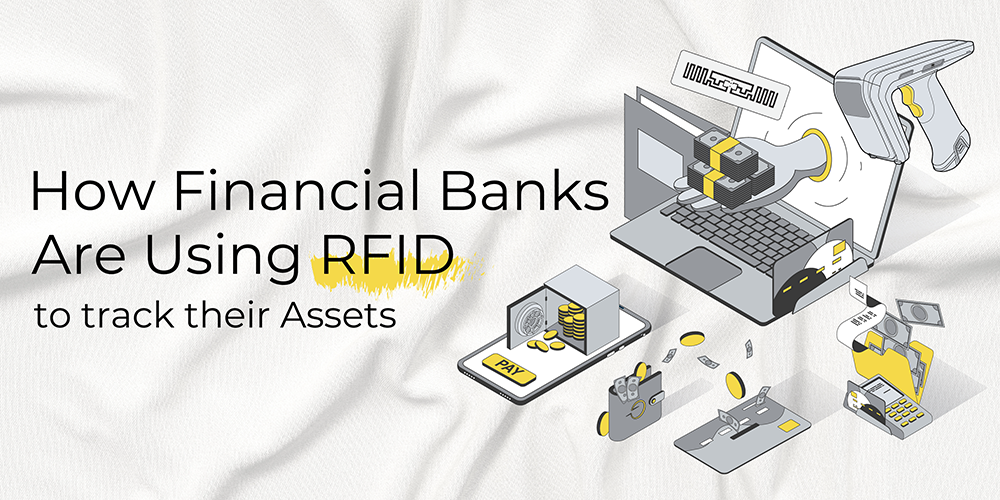In the fast-paced world of financial banking, efficient asset management is paramount for maintaining operational excellence, ensuring data security, and complying with regulatory standards. To meet these challenges head-on, financial banks are increasingly turning to Radio Frequency Identification ( RFID ) technology. This groundbreaking solution enables banks to track and manage their assets with unprecedented accuracy and efficiency. In this blog post, we explore the challenge for any financial bank and the ways how financial banks are leveraging RFID to revolutionize their asset tracking.
The Basics of RFID Technology
RFID technology utilizes radio waves to wirelessly identify and track objects equipped with RFID tags. In the context of financial banks, this translates into a sophisticated system where every asset, especially IT assets – from servers and computers to networking devices – is affixed with a unique RFID tag containing pertinent information. This technology offers a comprehensive solution for asset tracking, helping banks overcome the challenges associated with manual tracking methods.

Challenges
From any IT equipment including computers, laptops, networking equipment to the other vital assets like cash, ATMs, vaults, cash sorter machines,courier bags, or cheques management and tracking of them at any financial banks can be laborious and prone to human mistakes. Also,Manual tracking of files, documents or other valuable assets and ensuring all of them are safe and even moved from one department to the others safely, requires a big amount of resources and is possibly a risk too.
Here are a few benefits of RFID which any financial institution can adopt and can solve the challenges.
Real-time Visibility:
Visibility on each asset, especially if a bank is large and has multiple branches or departments is very important and to ensure that assets are where they are supposed to be. RFID technology provides financial banks with real-time visibility into the location, movement, and status of their assets. This instantaneous information ensures that the banks can quickly locate assets, reducing the risk of loss or theft and enhancing overall operational efficiency.
Inventory Management:
Taking manual inventory count takes a lot more effort and time. RFID technology enables automated inventory Tracking. RFID Tags can be applied on each asset in the bank and RAIN RFID handheld readers can be used to scan them to conduct quick and accurate inventory. This automation reduces the time and effort required for manual asset tracking.
Automated Tracking:
Unlike traditional methods that rely on manual data entry or barcode scanning, RFID allows for automated tracking. Whether it is IT hardware, office equipment, Files or any mining hardware RFID can be applied on all of them and can be turned into manual intervention to RFID automation which reduces human errors, time consumed and accelerates the tracking process.
Enhanced Accuracy:
RFID technology offers a level of accuracy that surpasses traditional tracking methods. With unique identifiers on each RFID tag, financial banks can precisely identify and differentiate between similar assets. This accuracy is crucial for compliance, audit trails, and maintaining an accurate inventory of assets.
Improved Security:
The security of bank assets, especially IT assets, is a top priority for financial banks. Equipment misplacement can also be a problem, particularly if it is relocated to a new area without the system being updated. Monitoring and accounting for the numerous, frequently vital, and highly valued assets found in financial banks is crucial. RFID technology makes it simple to detect assets by using RFID handheld readers to locate the misplaced assets. Not only does this save man-hours but also secure your assets.
Compliance and Audit Readiness:
In finance, compliance is non-negotiable. Audit of their assets in a time interval is important and crucial. RFID technology helps banks stay compliant with regulations by helping them keep precise records on the movements of their assets and alarm for a timely audit. RFID software helps to generate various reports and the data is a dependable source for not only confirming the existence and state of important assets during audits but aid them in resource allocation, equipment upgrades and can be analyzed to gain insights into asset utilization, predict maintenance needs, and optimize resource allocation within the financial bank.

Implementing RFID in Financial Banks
Financial banks typically deploy RFID technology by implementing the below:
a. RFID Tags : Affixing RFID tags to each asset.
b. RFID Readers: Using Handheld RFID readers to read the tags applied on the assets and extract the information about the assets.
c. RFID Software: Utilizing specialized Asset Tracking software for managing and monitoring RFID-tagged assets.
Conclusion
In conclusion, financial banks are leveraging RFID technology to transform their asset management processes. By embracing real-time visibility, automation, accuracy, and improved security, banks can ensure the seamless operation of their infrastructure. The adoption of RFID is not merely a technological upgrade but a strategic move toward enhancing efficiency, reducing risks, and maintaining a competitive edge in the ever- evolving financial industry. As technology continues to advance, RFID remains a powerful tool for financial banks committed to optimizing their asset management practices.
